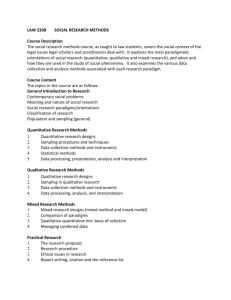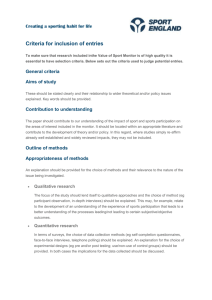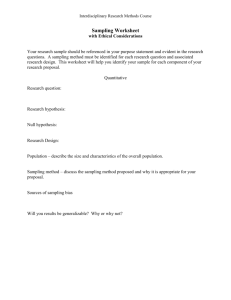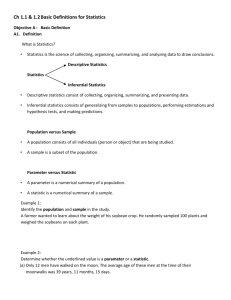Methods Of Research Exam
advertisement
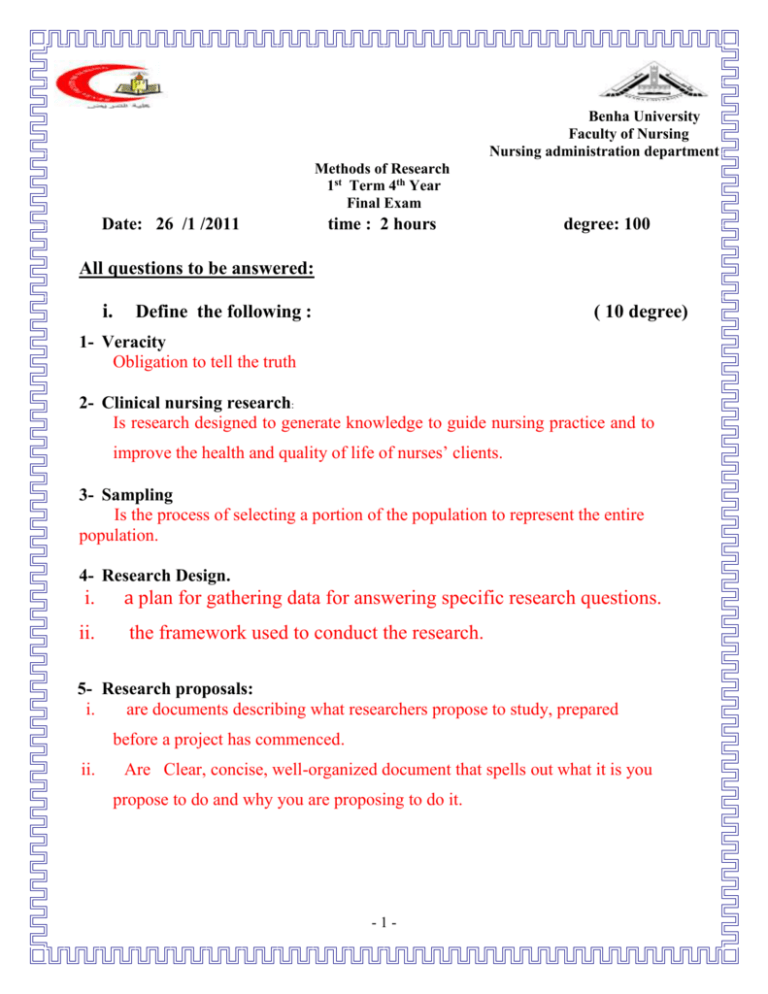
Benha University Faculty of Nursing Nursing administration department Methods of Research 1st Term 4th Year Final Exam Date: 26 /1 /2011 time : 2 hours degree: 100 All questions to be answered: i. Define the following : ( 10 degree) 1- Veracity Obligation to tell the truth 2- Clinical nursing research: Is research designed to generate knowledge to guide nursing practice and to improve the health and quality of life of nurses’ clients. 3- Sampling Is the process of selecting a portion of the population to represent the entire population. 4- Research Design. i. a plan for gathering data for answering specific research questions. ii. the framework used to conduct the research. 5- Research proposals: i. are documents describing what researchers propose to study, prepared before a project has commenced. ii. Are Clear, concise, well-organized document that spells out what it is you propose to do and why you are proposing to do it. -1- ii. Short Answers ( 20 degree) 1- The specific purposes of nursing research include:- 1- identification, 2- description, 3- exploration, 4- explanation, 5- prediction, 6- and control 2 - Research reports can take various forms as:1- papers, 2- dissertations, 3-journal articles, 4-presentations at professional conferences 3-major class of quantitative study are: 1- Experimental designs: o Experimental o Quasi-experimental 2- Non-experimental designs: o � Descriptive o � Correlational 4- Types of biophysiologic measures are :- 1-in vivo measures. 2-in vitro measures. -2- 5-List ( 5) Qualitative Research Methods:- • Observation • In-depth interviews • Focus groups • Discourse/content analysis • Case studies • Oral history Video Text and Image analysis (documents, media data) 6- Types of qualitative self-report techniques are:1- -Completely unstructured interviews 2- Semi-structured (or focused) interviews 34- Focus group interviews. Life histories 5- The think aloud method 6- Personal diaries 7- The critical incidents technique . -3- iii. -Identify which of the following research could be Quantitative Research and which are Qualitative Research. ( 5 degree) 1- Bournes and Mitchell (2002) undertook an in-depth study to describe the experience of waiting in a critical care waiting room. The Answer ………………… Qualitative Research ……………………………………………………. 2- Hupcey (2000) undertook a study that involved the development of a model explaining the psychosocial needs of patients in the intensive care unit. Feeling safe was the overwhelming need of patients in the intensive care unit. The Answer …………………… Quantitative Research ……………………………………………………… 3- McDonald, Freeland, Thomas, and Moore (2001) conducted a study to determine the effectiveness of a preoperative pain management intervention for relieving pain among elders undergoing surgery. The Answer …………………… Quantitative Research …………………………………………………… 4- Sadala and Mendes (2000) explored the experiences of 18 nurses who cared for patients who had been pronounced brain dead but kept alive to serve as organ donors. The Answer …………… Qualitative Research ………………………………………………………………. 5-Reynolds and Neidig (2002) studied the incidence and severity of nausea accompanying combinative antiretroviral therapies among HIV infected patients, and explored patterns of nausea in relation to patient characteristics. The Answer …………………… Quantitative Research …………………………………………………… -4- iv. matching ( 5 degree) No A 1 Person undertaking the study No 1 B Directional hypothesis 2 System of organizing concepts 2 dependent Variable 3 Study participant 4 Relationship between a single independent 3 variables and a single dependant variable Information gathered 4 5 variables that the researcher creates. 5 Deductive reasoning 6 6 Qualitative Research 7 It is a process by which specifics are inferred from general principles. Build theories 7 Theory 8 Person contributing information 8 active variables 9 Specifies not only the existence but the 9 expected direction of the relationship That which is being investigated 10 10 The answer Concepts Simple hypothesis Inductive reasoning 11 Quantitative Research 12 Data 13 Investigator 1 2 3 4 5 6 7 8 9 10 13 7 9 12 8 5 6 3 1 4 -5- v. - True or false ( 15 degree) No Statement T F 1 Research is not systematic inquiry that uses disciplined methods to T answer questions or solve problems. 2 A problem statement is an expression of dilemma or disturbing T situation that needs investigation . 3 Closed ended questions allow participants to respond to question in F their own words 4 Interview after the possibility of complete anonymity. F 5 When an attribute is extremely varied in the group under T investigation, the group is said to be heterogeneous 6 in non experimental research, researchers make observations of T existing situations and characteristics without intervening. 7 Research questions direct rewording of statements of purpose T interrogatively rather than declaratively. 8 Background of the problem need to provide a brief, focused review of T the literature 9 The proposal is comprehensible to only expert in the field F 10 The most common scaling technique is the visual analog scale. F 11 Sample in Qualitative Research is large sample. F 12 Life histories are narrative self disclosures about individual life experiences 13 Researcher used standardized instruments in Qualitative Research. 14 Open ended questions are more difficult to construct 15 Qualitative Research is test theories -6- T F F F vi. -- Differentiate ( 15 degree) 1- Basic research and applied research. Basic research applied research Undertaken to advance knowledge Undertaken to remedy a particular in a given area, helps the researcher problem or modify a situation, helps the understand relationships among researcher to make decisions or evaluate phenomena. techniques. (Clinical nursing problems). Pursuit of knowledge or finding truth Knowledge intended to directly influence clinical practice Generates, refines or tests theory Often uses laboratory setting conditions Findings may not be directly useful in practice Conducted in actual practice Solve problems, make decisions, predict/control outcomes May be used later in development of Evaluate interventions treatment/ drug/ theory Test/validate theories Evaluate “Basic” research knowledge for usefulness -7- 2- Probability sampling and non Probability sampling Probability sampling Non Probability sampling (random sample): It is a sample which is (non-random sample): This is sample chosen so that every member of the chosen according to the person's own population is equally likely to be a member of judgment so result cannot be generalized the sample. to the whole population. A- Simple random sample: This a sample There are three types of non drawn in such way that every individual in probability sampling: the population has an equal chance of appearing in the sample. A- convenience sampling: It uses B- Stratified random sample: In this case, participants who are easily accessible to we start by dividing the population into the researcher and who meet the criteria different strata according to their of the study. characteristics (e.g. male and female, different age groups, rural and urban). Then Snawball sampling: It is a particular from each of those strata, we choose a type of convenience sampling in which random sample from each stratum, the final the researcher net works with a small sample is the total of the samples from sample of accessible participants and use them to assist in identifying other different strata. participants with the specific trait. C- Cluster sampling: In this case the population first divided in to clusters or B- Quota sampling: In this case the groups as sample units rather than individuals population are divided into strata then and all the elements within the chosen cluster the researcher determines which strata are examined (e.g. house holds, schools) and are to be studied, then computers -8- the sample is selected from these clusters by number of participants needed for each simple random method. strata, once quota for each strata is determined, the subjects are solicited via D-Multistage sampling: in this case the a convenience sampling method. sample is taken in a series of stages. First, start by big clusters (e.g. zones) from this draw a sample, each zone is then divided into cities and villages, and from each of these you can choose a sample, from each city choose a district or house by random method, and then randomly draw a sample of families or individuals. E- Systematic sampling: Relies on arranging the target population according to some ordering scheme and then selecting elements at regular interval through the ordered list. In this case we choose every Nth individual e.g. every 5th, 10th, etc., the first one to be included should be randomly selected. o -9- C- Purposive/theoretical/judgemental sampling: In this type, the researcher based on knowledge and expertise of the subject, selects or hand picks the elements of the study. The chosen element are though to best represent the phenomena being studied. vii. -Write one research proposal, either quantitative or qualitative for problem you select. ( 25 degree) According to the problem you select, you must present it in this sequence:- - Title Introduction Significance of the problem Aim of the study Research question Subject and methods Research design Setting Subject Tools of data collection Methods of data collection Results discussion Conclusion Recommendation Reference Good luck Dr : Mahboba Sobhy Dr: Latifa Tawfik - 10 -
